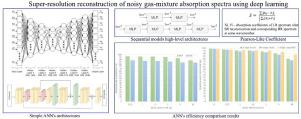Journal of Quantitative Spectroscopy and Radiative Transfer ( IF 2.3 ) Pub Date : 2022-05-27 , DOI: 10.1016/j.jqsrt.2022.108278 Yu. V. Kistenev , V.E. Skiba , V.V. Prischepa , D.A. Vrazhnov , A.V. Borisov

|
The laser sources used in absorption spectroscopy of gas media are a compromise between spectral turnability and line width. For example, optical parametric oscillators have a very wide tuning range, but also have a rather wide laser radiation linewidth.
To mitigate the disadvantages of the latter, an approach to absorption spectroscopy gas-analysis spectral resolution improving using super-resolution (SR) reconstruction is proposed. It was implemented using several machine learning models based on different artificial neural network (ANN) architectures, including an original sequential ensemble ANN approach. The problem of random noise influence on SR reconstruction quality was resolved in two ways: (i) by learning convolutional neural networks with noisy spectra, (ii) by high-frequency noise preliminary decreasing, using Gaussian or Fast Fourier Transform filtering.
The following ANN architecture models were designed and tested: convolutional neural network (CNN) and multilayer perceptron (MLP). The former performed at a lower accuracy compared to the latter.
ANNs' sequential combination was implemented when each subsequent ANN used the results of previous ANN data processing. This architecture pursues a paradigm of ensemble algorithms. Sequential models consisting of two or five MLP ANNs were designed and tested. In general, at low noise, the sequential models provided better SR reconstruction quality compared to the single-stage MLP ANN. When the noise amplitude was 4% and more, the sequential models demonstrated 3–8% worse accuracy than the single-stage MLP ANN, even using filtering. Therefore, the sequential models are quite accurate and effective in combination with effective filtering in cases of moderate noise level.
中文翻译:

使用深度学习对噪声气体混合物吸收光谱进行超分辨率重建
用于气体介质吸收光谱的激光源是光谱可转动性和线宽之间的折衷。例如,光学参量振荡器具有非常宽的调谐范围,但也具有相当宽的激光辐射线宽。
为了减轻后者的缺点,提出了一种使用超分辨率(SR)重建来提高吸收光谱气体分析光谱分辨率的方法。它是使用多个基于不同人工神经网络 (ANN) 架构的机器学习模型实现的,包括原始的顺序集成 ANN 方法。随机噪声对 SR 重建质量的影响问题通过两种方式解决:(i)通过学习具有噪声频谱的卷积神经网络,(ii)通过高频噪声初步降低,使用高斯或快速傅里叶变换滤波。
设计和测试了以下 ANN 架构模型:卷积神经网络 (CNN) 和多层感知器 (MLP)。与后者相比,前者的精度较低。
当每个后续的 ANN 使用之前的 ANN 数据处理的结果时,就实现了 ANN 的顺序组合。该架构追求集成算法的范式。设计和测试了由两个或五个 MLP ANN 组成的序列模型。一般来说,在低噪声下,与单级 MLP ANN 相比,序列模型提供了更好的 SR 重建质量。当噪声幅度为 4% 或更高时,即使使用滤波,序列模型的精度也比单级 MLP ANN 差 3-8%。因此,在中等噪声水平的情况下,序列模型与有效过滤相结合是非常准确和有效的。



























 京公网安备 11010802027423号
京公网安备 11010802027423号